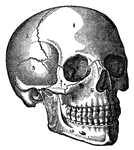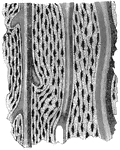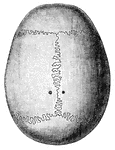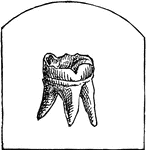Bones of Arm
Arm of humans; h Humerus or bone of upper arm; r and u Radius and Ulna, or bones of the forearm; c Carpus,…

bones of arm
Wing of Bird; h Humerus or bone of upper arm; r and u Radius and Ulna, or bones of the forearm; c Carpus,…

Chimp Limb
The forelimb of chimpanzee. (c) collar bone; (s) shoulder blade; (h) humerus; (r) radius; (u) ulna;…
Chimp Limb
The hindlimb of chimpanzee. (i) innominate bone; (f) thigh bone; (t) tibia; (s) fibula; (r) bones of…
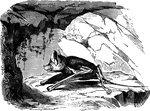
Rhinopomus Microphyllus
"The bats of this genus have a long, slender tail, without hair, looking like a sharp, jointed bone,…
Fort Taylor
"Fort Taylor, Key West, Fla. Key West, the most western of the Pine Islands, is about sixty miles southwest…

War in Mississippi
"The war in Mississippi- defeat of Wirt Adams's Confederate cavalry by the Second Wisconsin cavalry,…
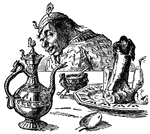
Marrow Bone
The Queens dwarf maliciously sqeezes Gulliver's legs into a hollow marrow bone durning dinner.

Moa skeleton
The partial skeleton of a moa, an enormous flightless bird once native to New Zeland, now extinct.

Perch skeleton
"The bones of fishes are of a less dense and compact nature than in the higher order of animals; in…

Bone of the cuttle-fish
"An internal support of a calcareous nature, and formed in laminae; this is the well-known cuttlefish…

Clio borealis
"The species of the genus Clio, belonging to this order, exist in prodigious numbers in the…

Side View of Bones in Foot
"The Foot is that part of the lower extremity below the leg on which we stand and walk. It is composed…

Side View of Bones in Foot
"The Foot is that part of the lower extremity below the leg on which we stand and walk. It is composed…

Whale
"Whale is a name that may be taken as equivalent to Cetacean, and applied to any member of that order…

White fibrous tissue
"The connective tissue with white fibers sometimes forms a very thin sheet, as in the delicate covering…

Softened fibula
"The Fibula tied into a Knot after the Mineral Matter has been dissolved by Acid." — Blaisedell,…
Cross-section from a shaft of a long bone
"Little openings (Haversian canals) are seen, and around them are arranged rings of bone with little…
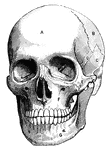
Human skull
"A, frontal bone; B, parietal bone; C, temporal bone; D, sphenoid bone; E, malar bone; F, upper jawbone;…
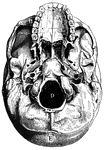
Base of skull
"A, Palate process of upper jawbone; B, zygoma, forming zygomatic arch; C, condyle, for forming articulation…
Spinal column
"The spine or backbone, serves as a support for the whole body. It is made up of a number of…

Scapula
"The shoulder-blade is a large, flat, three-sided bone, which is placed on the upper and back…
Humerus
"The humerus, a long, hollow bone, rests against a shallow socket on the shoulder blade. It…
Ulna and Radius
"The ulna, or elbow bone, is the larger of these two bones. It is joined to the humerus by…
Tibia and Fibula
"The leg consists, like the forearm, of two bones. The larger, a strong, three-sided bone with…
Bones of the Foot
"The foot is built in the form of a half-dome or half-arch. This is to afford a broad, strong support…

Elbow Joint
"Showing how the Ends of the Bones are shaped to form the Elbow Joint. The cut ends of a few ligaments…

Ligaments of the Foot and Ankle
"The bones are fastened together, kept in place, and their movements limited, by tough and strong bands,…

Broken Radius
"When a bone is broken, blood trickles out between the injured parts, and afterwards gives place to…
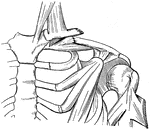
Broken Clavicle
"When a bone is broken, blood trickles out between the incjured parts, and afterwards gives place to…

Broken Tibia
"When a bone is broken, blood trickles out between the injured parts, and afterwards gives place to…
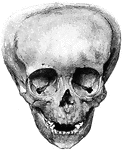
Deformed skull
"Showing how the Bones of the Skull may be artificially deformed by "head-binding." From the photograph…

Longitudinal seciont of a fingernail
"A, last bone of finger; B, true skin on the dorsal surface of finger; C,…
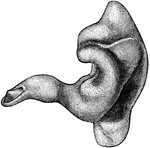
External auditory canal
"A Cast of the External Auditory Canal. The auditory canal is a passage in the solid potion of the temporal…
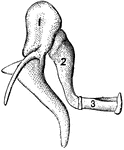
Bones of the Ear
"1, malleus, or hammer; 2, incus, or anvil; 3, stapes, or stirrup." — Blaisedell, 1904

Skeleton of the Mammoth
"Mammoth is a species of extinct elephant, the fossil remains of which are found in European, Asiatic…

Front view of the larynx
"Cartilages and Ligaments of the Larynx. (Front view.) A, hyoid bone; B, membrane…
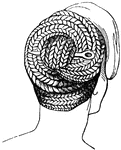
Acus
"A needle, a pin. Pins were made not only of metal, but also of wood, bone, and ivory. They were used…

Jackstraws
"This is a game of pure manual dexterity, and is rare practice for cultivating steadiness of hand and…
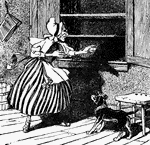
Mother Hubbard
Old Mother Hubbard went to the cupboard to get her poor dog a bone; But when she came there, the cupboard…
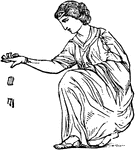
Talus
"Talus. The huckle-bones of sheep and goats were used to play with from the earliest times, principally…
Sword
A type of sword called cleddyo. Usually made of bronze and having a "leaf shape" form. the tounge being…
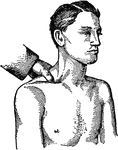
Subclavian compression
"In bleeding from wounds of the shoulder or armpit the subclavian artery may be reached by pressing…
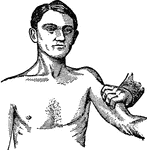
Branchial compression
"In bleeding from any part of the arm or hand the branchial artery should be pressed outwards against…
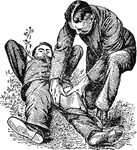
Femoral compression
"In bleeding from the thigh, leg, or foot press backward with the thumbs on the femoral artery at the…

